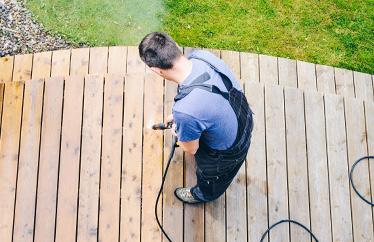Figuring out your home’s flood risk may not be at the top of your to-do list, but it’s one of the most important things to know as a homeowner. Before you risk drowning in costly damages, learn how to determine if your home is in a flood area and prepare for potential floods.
Is my home in a flood zone?
Just because you don’t live near water or haven’t experienced flooding before doesn’t mean you’re not in a flood zone. Most homes have at least some degree of flood risk, regardless of their location. The Federal Emergency Management Association (FEMA) says even with low or moderate flood risk, your home is still five times more likely to flood than experience a fire over the next 30 years.
To check if your home is in a flood zone, input your address on FEMA’s Flood Map Service Center. The map looks confusing at first glance, but here are some tips you can use to understand your results better.
Reading and understanding a flood map
Flood maps help you determine if your community is at risk for flooding. They show a community’s flood zone baselines, flood zones, and base flood elevation.
Each flood map contains zones, and each flood zone determines a property’s insurance requirements and costs. These zones range from low and moderate risk to high risk. According to FEMA, between 2014 and 2018, more than 40% of flood insurance claims came from outside high-risk flood zones. It doesn’t matter where you are; everyone lives in a flood zone. Each risk area is tied to a letter on the map.
- Low to moderate-risk areas have the letters B, C, and X on FEMA flood maps. While the risk of being flooded is lower in these areas, it still exists.
- High-risk flood areas have the letters A or V on FEMA flood maps. If you have a home in a high-risk flood area with a federally insured mortgage, you’re required to buy flood insurance.
How to track changes to your home’s flood risk
Flood risk changes over time. That’s why the National Flood Insurance Program and FEMA work with communities across the country to review flood zones on an ongoing basis. What’s the best way for you to keep up as a homeowner? The first step is to check your home’s flood risk every five years using FEMA’s Flood Map Service Center.
You can record your home’s information and risk levels on Flood Factor, an app that allows you to view interactive flood maps to see how flood risk changes over time. Created by industry experts, the models review historical flood data to predict future changes. The app and its information can also be found on leading real estate websites, including Redfin and Realtor.com.
How to protect your home from flooding and flood damage
Regardless of whether your home’s flood risk is low or high, it’s crucial to take preventative action to protect your home and property.
Invest in home upgrades to prevent flooding
Here are just some of the most effective ways to make your home more flood and weather-resistant:
- Clean your drains and gutters. Less debris gathers in clean drains, preventing water from backing up.
- Add waterproofing insulation and drywall to your basement.
- Install a check valve– a device that only allows the flow of liquids in one direction to prevent backflow in your pipes.
- Fill any gaps around your windows and doors with caulking.
- Check for holes and gaps around any wires and pipes to prevent water seeping into these spaces.
- Use tile instead of carpet for your floors. The right tile can be resistant to flooding, mold and/or mildew. It is also much easier to keep clean.
- Direct your gutter runoff away from your house. Changing the direction ensures water won’t pool in the corners of your property.
- Add extra space between your mulch and siding. If there’s additional space between your mulch and siding, your home can completely dry after a storm or heavy rain.
- Raise all of your electrical sockets. Sockets, circuit breakers, and outlets should be at least a foot above the ground to avoid water during floods.
- Tilt your lawn away from your house and add rainwater pools near your home. The water can run toward the street when the lawn is tilted away from your home, saving you the headache of water saturating your foundation.
- Consider putting your home on stilts. Although expensive if done retroactively, elevating your home gives it an additional layer of protection from water damage.
Learn how to check for flood damage
Flood damage can show up in many different ways, but here are some of the most common signs of flooding:
- Mold and mildew: According to FEMA, mold and mildew can start to form on damp surfaces within 24 to 48 hours. As soon as your home is deemed safe, start drying out your home and personal items.
- Damage to your appliances: Your air conditioning system, water heater, refrigerator, and ventilation systems are all vulnerable to water damage. If you notice they’re wet, unplug them and dry them out immediately. Then make sure you hire a professional to inspect them before attempting to use them again.
- Structural damage: This can appear as foundation and roof cracks or buckling in the floors (there may be water beneath it).
- Electrical damage: Take a look wherever your home runs electricity to see if there are any frayed or fractured electrical wires. This includes:
- Lights
- Heaters
- Circuit panels
- Fuse boxes
- Switches
- Outlet receptacles
- Circuit boards
- Air conditioners
- Furnaces
- Boilers
If there are any wet wires, avoid touching them until an electrician can check your home to be sure it’s safe.
Review your homeowners insurance policy for flood protection
You determine your home is at low risk for flooding—so there’s no reason for flood insurance, right? Wrong. You may still want to consider flood insurance no matter where you live.
Start by reviewing your current homeowners insurance policy for fine print related to flooding. Most insurance companies don’t include flood protection in a standard insurance policy; it’s usually offered as separate coverage, an insurance rider. Sometimes, it’s even required. For example, flood insurance may be required regardless of your flood zone if you have a federally-insured mortgage.
Your home insurance provider should partner with you to walk you through your coverage options, explain flood insurance riders and help you add it to your policy if you need to.
Whether you’re living in a low-risk flood area or riding the waves next to your beach home, Hippo prepares you and your home with the resources you need. Each new homeowners insurance policy receives a smart home kit with sensors that detect water leaks and send alerts straight to your phone.
Take action now and get a home insurance quote online today.




